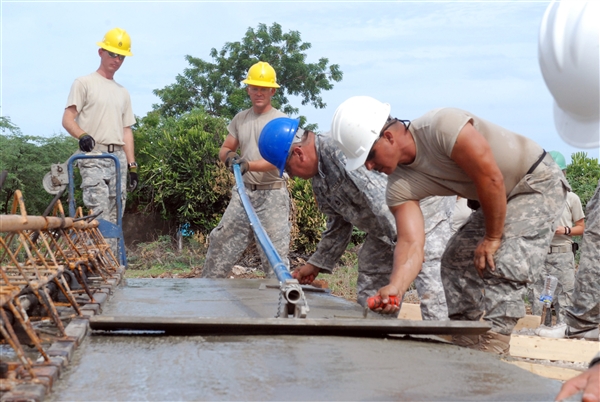WASHINGTON, Dec. 16, 2010 — As NATO forces make progress in training the Afghan security forces, they’re also helping to teach 146,000 Afghan soldiers and 115,000 police how to procure the equipment they need.
“Our mission is to help the government of Afghanistan generate and sustain the Afghan army and police, all the way from the ministerial systems — essentially, their version of the Pentagon — through their operational commands, down to the individual units,” said Army Col. John Ferrari, deputy commander for programs for NATO Training Mission Afghanistan and Combined Security Transition Command Afghanistan, during a “DOD Live” bloggers roundtable yesterday.
Though the current Afghan national security force is 250,000 members strong, Ferrari said, plans call for growing Afghanistan’s security forces to 171,000 soldiers and 134,000 police by October, he said.
Although American forces are procuring the equipment for the Afghan people, plenty of that equipment is not of American origin. Ferrari said.
“One of the top challenges we have here in Afghanistan,” he said, “is that the Afghan population has been traumatized by 30 years of war. … One of the casualties of that war was the destruction of the education system. What we have now is a population that is mostly illiterate.”
This, Ferrari explained, presents a problem in procuring Western weapons.
“Most of the soldiers and police, when they come in, don’t understand what a number is,” he explained. “So if you’re looking at a serial number on a weapon, they don’t understand what the numbers are, and they have an inability to sign their name. … We’ve decided to keep them with a weapon that they know and understand.”
Aircraft such as the Mi-17 helicopter are especially appropriate for the unique terrain of Afghanistan, which is why it has been procured for the Afghan forces, Ferrari said. “The Soviets designed the Mi-17 for Afghanistan,” he said. “And so it’s the only aircraft in the world that was designed specifically for the terrain and for the altitude and the weather here. And so when they started up the air program, the Afghan pilots knew how to fly and maintain the Mi-17.”
Plans call for moving toward Western equipment as literacy rates and availability rise, the colonel said.
“We are trying to move away from those Soviet-type weapons to Western aircraft or Western vehicles,” he said. “So on the vehicle front we’re buying International trucks as their medium truck. We’re buying up-armored Humvees. We’re buying Ford Rangers. And on the aircraft, [we’re buying] C‑27s, a Western aircraft.”
The move away from Soviet-style weapons is something training mission officials plan to do as they introduce new equipment to the Afghans, such as night-vision goggles, Ferrari said. Western radios also are part of the equation, he added.
“We started with Soviet-type weapons because that was what was here, and it was easy to start with,” he explained. “But over time, as we bring up their literacy rates, as we’re here longer, as their training increases, we have a concerted effort to introduce Western equipment.”
The push toward literacy was due in part to U.S. Ambassador Richard C. Holbrooke, a special envoy to the region, who died Dec. 13, the colonel said. Holbrooke, he added, foresaw how illiteracy could affect the then-burgeoning Afghan police force in terms of corruption.
“It was his belief — correctly, as it turns out — that a large part of [corruption] was due to the fact that the police were illiterate,” Ferrari said.
Taking Holbrooke’s advice, Army Lt. Gen. William B. Caldwell IV, commander of the training effort in Afghanistan, put literacy pilot programs into place, and the training soon became a “very big recruiting tool,” Ferrari said.
Slowly but surely, the training efforts in Afghanistan are showing signs of progress and hope for the Afghan people, the colonel said.
“We are starting to see signs that the quality of the force is improving, both in the training base and in the recruits we’re getting, and out in the field,” he noted.
Ferrari acknowledged, however, that the rapidly growing force — which met this year’s growth targets three months early – still faces challenges.
“I don’t want to leave anybody with a false impression that we’re done and everything’s going extremely well,” he said. “There are significant challenges and hurdles ahead, but we’re prepared to overcome them and help the Afghan security forces take the lead.”
Source:
U.S. Department of Defense
Office of the Assistant Secretary of Defense (Public Affairs)

 von
von 